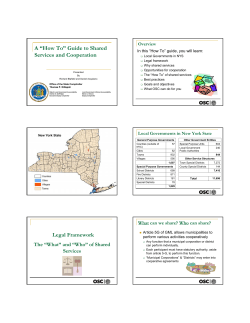
Making Education a Major Priority: An Election Year Message
Making Education a Major Priority: An Election Year Message to President Obama and Governor Romney The National School Boards Action Center (NSBAC) is a not-for-profit organization founded by the National School Boards Association (NSBA) to advocate at the federal and national levels for the advancement of public education, local school board leadership and excellence and equity in our nation’s public schools. Across the nation, 90,000 local school board members are responsible for governing nearly 14,000 school systems serving 50 million public school students. Elect Education Making Education A Major Priority: An Election Year Message to President Obama and Governor Romney Over the next four years Presidential vision and leadership to achieve essential national goals will significantly shape the direction of our nation for decades to come. Certainly, how a world-class education is valued and pursued for schoolchildren today will influence life in America and how tall we stand on the world stage tomorrow. We know that a well educated citizenry is essential to the progress of our great nation as an economy, a land of individual opportunity, and the standard of living of its people. We know that the need for a first rate education is more important today than ever as knowledge and technology continue to reshape the workplace and how our society functions. We see other nations, through improvements to their education systems, increasingly producing high-skilled workers as they compete with the United States to attract businesses and jobs to build their economies. Given these trends, our nation needs to put education on a forward-moving path over the next four years to ensure that today’s schoolchildren and the nation are prepared for success in the future that lies ahead. Having a world-class education that is second to none requires that all our people and all sectors of government, business, and civic life place a high priority on K-12 education. To provide the leadership that’s necessary, no person in America commands the attention of the nation more than the President of the United States. That’s why school board members believe that over the next four years, our President must make strengthening our nation’s schools a foremost priority and compellingly convey to the American people the urgency of the mission and their part to achieve it. Beyond providing a strong national voice, the President must also promote the federal programs that are needed and invest the political capital to then secure timely action by members of the U.S. Congress, regardless of party affiliation. The National School Boards Action Center (NSBAC) is presenting this paper to outline the expectations and priorities that local school board members, as elected public office holders in their communities, see as necessary Presidential leadership and action steps to prepare our students for success in college and careers. A Proactive Federal Agenda for Education Foremost, the education agenda for the next four years must begin with the urgent need to reauthorize the Elementary and Secondary Education Act (ESEA). Over the 11 years since the last reauthorization, our nation’s schools have been struggling under the well-intended but badly flawed No Child Left Behind Act (NCLB). This fall, high school seniors will have nearly experienced their entire school career without the benefit of a well designed federal program for addressing the current challenges in American education. The President should make every effort to bring the next Congress together to produce legislation by June 30, 2013 so that the nation’s school systems can be prepared for implementing a new law when school opens for the 2013-14 school year. In working with the Congress and then in implementing that law and other initiatives over the next four years, the President and his Department of Education should give primary attention to the following areas where the federal government can significantly contribute to a world-class education. Seven Key Areas for Federal Attention Over the Next Four Years Standards and Assessments Rigorous state standards and the accompanying assessments of student performance are essential for a world-class education. The federal government can play a role in supporting states in the development of standards and assessments in key subject areas. However, to prevent the federalization of our nation’s schools and to ensure that states have the flexibility to innovate and be laboratories for improvement, the federal government should not develop national standards or assessments or condition the receipt of federal grants on the adoption of any specific standards or assessments. Accountability It is also essential that schools are held accountable for students achieving high standards. However, as NCLB repeatedly taught us over the past 11 years, the system must be designed correctly, including measuring individual student growth. Accountability should not be based on one state standardized test given on a single day, which-- among NCLB’s other flaws-- leads to teaching to the test. In creating an accountability framework for the states, there must be flexibility to use multiple assessments of student performance that measure higher order thinking skills and the ability to use academic knowledge, such as student projects and classroom observation. All schools should seek to continuously improve. However, the closest scrutiny and oversight should be reserved for a state’s lowest performing schools, including providing local school systems with the support and flexibility needed to design and implement high quality improvement programs that they determine will best meet the needs of students in those schools. Local Capacity Building While rigorous standards and assessments are necessary to set a high bar for a world-class education, the result will not be realized unless local school districts have the information and resources needed and are provided a reasonable time to successfully implement them. Specifically, ESEA and other programs should ensure that practical, adequately funded, research-based program options and information are available to school districts to 1) provide professional development for teachers and administrators to successfully teach and design curriculum that meet new and higher standards; 2) acquire and maintain data systems to assess and diagnose individual student performance; 3) integrate education technology and acquire course materials that are aligned with new standards; and 4) obtain technical assistance from the state, universities, or other sources of their choosing. More generally, by supporting research and the dissemination of best practices, the federal government can provide a great service to school districts in identifying proven programs and approaches that best meet their needs and circumstances. Teacher/Principal Effectiveness A world-class education requires world-class teachers and school leaders. The ESEA reauthorization and other federal initiatives can provide incentives, through funding, best practices, and other resources to help prepare our educators to teach at the level needed througheffective pre-service training at colleges of education, high -quality alternative teacher certification programs and on going professional development. Federal initiatives can also help jump-start locally-determined innovations such as incentives and rewards for excellence in teaching, including merit pay, career ladders, and mentoring programs. School systems may also benefit from technical and financial support in developing and implementing teacher and principal evaluation systems so that effectiveness can drive their rewards, assignments to schools, professional improvement strategies, or cause for removal—all designed to benefit students. In designing evaluation systems, states and school systems should be able to determine how student test scores will be used in local school systems. Finally, the federal government should not be involved in determining teacher credentialing or licensure or placing conditions in federal grant programs for the qualifications that teachers must possess to teach specific subjects beyond those qualifications established by the state. Preschool Education The federal government should invest in preschool education by creating a major formula grant program to support school districts to voluntarily establish and maintain preschool programs. Research shows that preschool education produces a high return on investment by reducing the need to provide multi-year remedial programs for students who are not otherwise prepared to begin school. Moreover, research also shows that preschool education increases the earning potential that these students will enjoy as adults. However, a federal initiative in this area must not weaken K-12 education by trading off support for those programs as its source of funding. To be successful, programs operated by preschool providers that receive federal funds must be aligned with local school district learning expectations so that preschoolers will be prepared to achieve in their neighborhood public schools. Addressing Student Diversity and School Systems With High Needs The more diverse schools, school districts, and states become diverse in the racial and national backgrounds of their students, the more attention that will need to be given to the special needs and challenges many of these children bring to school whether associated with poverty, cultural differences, limited English proficiency, or disability. In presenting a comprehensive plan for how the federal government can further assist states and local school districts to ensure that these children can achieve at a world-class level, Presidential leadership is called for, including creating a national initiative to improve education in urban districts where one third of the school population resides, including many high-need students. While less visible, rural school districts frequently experiencing limitations caused by size, geography, and remoteness also could benefit from strategies tailored to meet their needs. Federal Funding for Education While well designed initiatives in the above areas are needed, they alone will not bring success without an adequate investment of federal funding to support them. Here, the President can take the following important steps: Set forth a funding blueprint to match his vision for education. Seek funding increases for innovative school improvement initiatives that are in balance with the urgent need to fund formula-based programs like Title I and the Individuals With Disabilities Education Act (IDEA), that have a broadly based financial impact on the general school budget during this era of severe cutbacks in state and local funding. Work to avert cuts in education, such as budget sequestration, in recognition of the high priority our nation holds for education, the relatively large impact federal funding can have on raising student achievement, and the relatively small impact the current sequestration cut, for example, would have on the overall federal budget (8 one hundredths of 1%). Convene a presidential commission to study and make recommendations regarding the long term capacity of the state and local revenue base to support P-12 education at a world-class level in light of the economic challenges they face and the role the federal level must play to accomplish our national goals in education. Three Key Principles To Guide A Successful Role In K-12 Education In addressing “what” Presidential leadership can do to support a world class education, it is equally important “how” federal initiatives are developed and implemented. The National School Boards Action Center urges the President and his administration to work within the following principles to guide the formation and implementation of our nation’s national education policy. Support for Public Education As a key component of our nation’s infrastructure, the public schools educate 50 million schoolchildren or nearly 90% of America’s youth. Beyond the important and unique role that public education plays in a free and socially-mobile society, the sheer numbers of students make the compelling case for the public schools to be the focal point for ensuring all students have the opportunity to receive a world-class education. Accordingly, proposals for alternative approaches that are unproven and/or not easily replicated or scaled up, or which undermine neighborhood public schools, should be rejected. These proposals include vouchers for non-public schools as well as virtual schools that research shows frequently operate at high profit margins while only producing low academic student results. Similarly, public school alternatives, like charter schools, should be initiated in a manner that creates coordination with local school districts and which does not weaken neighborhood public schools by diminishing their financial and other resources. These results are best achieved when charter schools are authorized and evaluated for renewal by the local school board in the communities in which they are located. Further, as an option, charter schools, like other innovations, should be promoted with their success rate in mind (e.g., a major well regarded national study found that only 17% of charters out-performed traditional public schools). And, where success is attained, the basis for success should be identified and taken to scale by determining and supporting its applicability in traditional public schools. Local School Governance and Administration While education is in the national interest and a state responsibility, the goals and objectives set at the federal level should not interfere with or dictate local implementation. It is at the local level that education takes place, and it is critical that local educators and policymakers have the flexibility to design and manage programs that meet local needs, resource capacity, and community values. In this regard, local school boards are elected (95%) or appointed for the express purpose of overseeing and improving educational systems consistent with local voter priorities and desires within the framework of state policy. Operationally, federal reporting and data collection requirements should be kept at the minimum needed to meet the central purpose of federal legislative programs. To be successful, federal policy must be approached with the broader function of the local level in mind. The Role of the U.S. Department of Education In promoting school improvement, it is clear that many of the top-down requirements from the federal level over the past decade have not worked. Instead, the federal government must challenge, inspire, and support local educators and school officials with an emphasis on creating constructive improvements with adequate funding that are locally developed to meet local needs and circumstances, and not punish schools or students should they fall short. In recent years, the U.S. Department of Education (ED) has assumed a substantially larger role in establishing federal policy in education, without what many believe was sufficient legislative authority for doing so. ED has, in effect, established an entire school improvement agenda around a series of broadly stated principles contained in the American Recovery and Reinvestment Act. In part because Congress was unable to act on the ESEA reauthorization, ED wisely utilized its legal authority to waive several harmful provisions of NCLB, but then required states to agree to significant conditions on how key areas of education would be approached in order to qualify for those waivers. Merits aside, in our democratic system of government, it should be the role of Congress, as elected representatives of the people, to establish major education policy. In exercising restraint at the federal level, it is also important that as ED moves forward over the next four years, that it recognize that success in achieving its agenda can be best secured by supporting the decision-making roles of local educators and local school boards in the operation and governance of their schools, including promoting local flexibility while avoiding mandates in federal programs. Conclusion Technology, global competition, an increasingly diverse population, and economic limitations both challenge and provide opportunities for raising student achievement. Especially with the critical role that P-12 education will play in our nation’s future success, local school boards look to Presidential leadership to rally the nation and promote a federal partnership with states and local school districts that will support a world-class education for all our nation’s schoolchildren. National School Boards Action Center For further information, visit our website at www.nsbac.org Alexandria, Virginia
© Copyright 2025





















